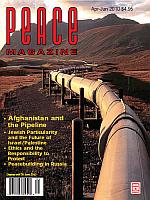
Peace Magazine Apr-Jun 2010, page 29. Some rights reserved.
Search for other articles by Rosalie Bertell here
By Alexey Yablokov, Vassily Nesterenko, and Alexey Nesterenko. Annals of the New York Academy of Sciences (Volume 1181)
This new publication is the elucidation many of us have been waiting for since the 1986 disaster at the failed nuclear reactor in Ukraine. Until now we have read about the published reports of spotty investigations by Western scientists who undertook projects in the affected territories. Even the prestigious IAEA, WHO, and UNSCEAR reports have been based on about 300 such Western research papers, leaving out the findings of some 30,000 scientific papers prepared by scientists working and living in the stricken territories and suffering the everyday problems of residential contamination with nuclear debris and a contaminated food supply.
Chernobyl: Consequences of the Catastrophe for People and the Environment is wrtitten by Alexey Yablokov, Vassily Nesterenk and Alexey Nesterenko. The senior author, Alexey Yablokov, was head of the Russian Academy of Science under Gorbachev; since then he receives no support. Vassily Nesterenko, head of the Ukrainian nuclear establishment at the time of the accident, flew over the burning reactor and took the only measurements. In August 2009, he died as a result of radiation damage, but earlier, with help from Andrei Sakharov, was able to establish BELRAD to help children of the area.
The three scientists who assembled the information in the book from more than 5000 published articles and research findings, (mostly available only within the former Soviet Union or Eastern block countries and not accessible in the West), are prestigious scientists who present objective facts clearly nuanced with little or no polemics.They were not encumbered by a desire to promote or excessively blame a failed technology!
The book was expertly translated into readable English by Janette Sherman, medical toxicologist and adjunct professor in the Environmental Institute at Western Michigan University. Professor Dimitro Grodzinsky, chair of the department of biology of the Ukraine National Academy of Sciences and member of the National Commission, wrote the preface. His statement regarding Western reporting of the accident is illuminating:
“For a long time I have thought that the time has come to put an end to the opposition between technocracy advocates and those who support objective scientific efforts to estimate the negative risks for people exposed to the Chernobyl fallout. The basis for believing that these risks are not minor is very convincing.”
The government of the former Soviet Union previously classified many documents now accessible to the authors. For example, we now know that the number of people hospitalized for acute radiation sickness was more than a hundred times larger than the number recently quoted by the IAEA, WHO, and UNSCEAR.
Unmentioned by the technocrats were the problems of “hot particles” of uranium that caused nasopharyngeal prob- lems, and the radioactive fallout that resulted in general deterioration of the health of children, widespread blood and lymph system diseases, reproductive loss, premature and small infant births, chromosomal mutations, congenital and developmental abnormalities, multiple endocrine diseases, mental disorders, and cancer.
The authors systematically explain the secrecy conditions imposed by the government, the failure of technocrats to collect data on the number and distribution of all of the radionuclides of major concern, and the restrictions placed on physicians against calling any medical findings radiation-related unless the patient had been a certified “acute radiation sickness” patient during the disaster, thus assuring that only 1% of injuries would be so reported.
This book is a “must read” for all of those bureaucrats currently promoting nuclear power as the only “solution” for climate change. Those who seek information on the disaster only from the official documentation provided by the IAEA, WHO, and UNSCEAR need to broaden their reading to include the reality check from those scientists who have access to local findings and are simply telling the truth, with no hidden propaganda agenda.
I was impressed by the simple message of the cover of this volume, which shows a number of felled logs with clearly distinguishable colors of wood: before and after Chernobyl. The reader will find that the environment, living plants and animals all suffered ill effects from this experience, as did the human population. It should be a sobering read for all those who have believed the fiction that “low doses of radiation are harmless” or that a severe nuclear accident is easily contained within the human environment.
You can order this book from the New York Academy at http://www.nyas.org/Publications/Annals/Detail.aspx?cid=f3f3bd16-51ba-4d7b-a086-753f44b3bfc1. Unfortunately, its selling price is now about $150.
Reviewed by Rosalie Bertell, Ph.D., an environmental health researcher.

Peace Magazine Apr-Jun 2010, page 29. Some rights reserved.
Search for other articles by Rosalie Bertell here